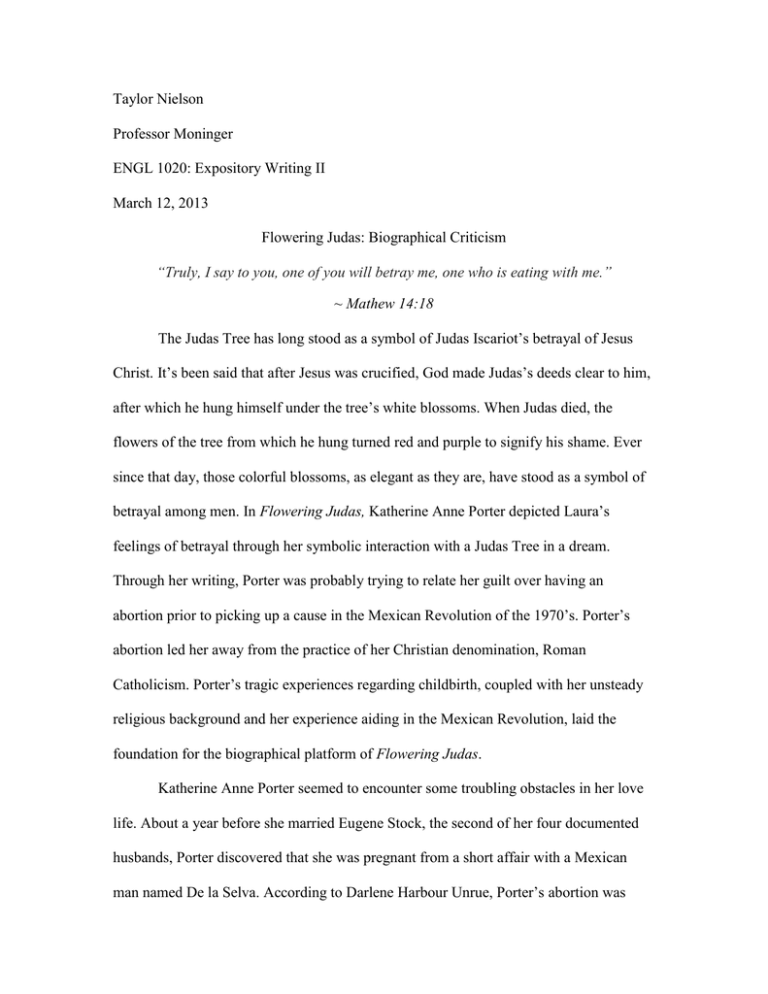Flowering Judas - Taylor Nielson
advertisement

Taylor Nielson Professor Moninger ENGL 1020: Expository Writing II March 12, 2013 Flowering Judas: Biographical Criticism “Truly, I say to you, one of you will betray me, one who is eating with me.” ~ Mathew 14:18 The Judas Tree has long stood as a symbol of Judas Iscariot’s betrayal of Jesus Christ. It’s been said that after Jesus was crucified, God made Judas’s deeds clear to him, after which he hung himself under the tree’s white blossoms. When Judas died, the flowers of the tree from which he hung turned red and purple to signify his shame. Ever since that day, those colorful blossoms, as elegant as they are, have stood as a symbol of betrayal among men. In Flowering Judas, Katherine Anne Porter depicted Laura’s feelings of betrayal through her symbolic interaction with a Judas Tree in a dream. Through her writing, Porter was probably trying to relate her guilt over having an abortion prior to picking up a cause in the Mexican Revolution of the 1970’s. Porter’s abortion led her away from the practice of her Christian denomination, Roman Catholicism. Porter’s tragic experiences regarding childbirth, coupled with her unsteady religious background and her experience aiding in the Mexican Revolution, laid the foundation for the biographical platform of Flowering Judas. Katherine Anne Porter seemed to encounter some troubling obstacles in her love life. About a year before she married Eugene Stock, the second of her four documented husbands, Porter discovered that she was pregnant from a short affair with a Mexican man named De la Selva. According to Darlene Harbour Unrue, Porter’s abortion was carried out in a small, unhygienic shack in Guanajuato, Mexico (86). From then on, Porter often fought with the guilt of terminating her pregnancy. Although she never renounced her decision, she often wrote about her guilt over one day having to face her sins. While writing Trinidad’s Story, Porter recorded on a note, “I have set my sails for death” (1). Soon thereafter, Porter contracted gonorrhea from Stock and had to undergo a hysterectomy. It’s easy to see that her dismay over her inability to bear a child distressed her terribly, and her decision regarding her previous pregnancy upset her even more so. These feelings of guilt show clearly in Flowering Judas, as the main character, Laura, has trouble engaging in romantic relationships with men. She wants to partake in such relationships, but it’s obvious that some prior circumstance holds her back. After she ignored the courting of a nineteen year-old boy, Laura speculated that she was, “gradually perfecting herself into the stoicism she strives to cultivate against that disaster she fears, although she cannot name it” (542). Through the guise of her character, Laura, Porter communicated her personal grieves in Flowering Judas. Roman Catholicism also played a leading role in the development of Flowering Judas. Laura, just like Katherine Anne Porter, had been raised as a staunch Catholic, but had wandered from her values for a period of time. Although Porter wrote Flowering Judas after regaining control over her spiritual life, she admitted that she strayed from those beliefs during the period of life upon which the story is based upon. At one point in the story, while being sung to by Braggioni, Laura reflected on a time when she slipped into a church to say a Hail Mary, “…in spite of her fear of being seen…” (539). This information provided to the reader about the author helps to convey the depths of Laura’s guilty conscience. As she ate from the Judas Tree, presumably as a symbol of taking communion in the betrayer Judas Iscariot as opposed to Jesus Christ, the reader is given some insight into the Laura’s deeper emotions. Once the reader has a better understanding of Porter’s biographical influence on Flowering Judas, they can learn a lot about the author and her emotional grievances. The aspect with perhaps the most identifiable influence on Flowering Judas is Porter’s experience in aiding Mexican Revolutionaries in the early 1920’s. One revolutionary, a prominent leader named Francisco “Pancho” Villa, resembles Braggioni almost too closely. A large, belligerent man, Villa was known to be harsh and cruel despite his passion to upturn the riches of the Mexican elite into the hands of the poorer citizens. Villa started his career as a common bandit and once he gained power, he became corrupt with the riches that he bestowed upon himself (PBS 1). Through the use of symbolism in Flowering Judas, Porter not only portrayed her experiences aiding in the Mexican Revolution, but she also gave the reader a view of her political opinions on the matter. Flowering Judas does not give a bad outlook on the necessity for a reformation of the Mexican government, but it’s obvious that Porter witnessed corruption in the political system that replaced the overthrown government. Through Porter’s portrayal of Braggioni’s gluttony and displays of arrogance, she portrays the revolutionaries as men of a corrupt, egotistical nature. Throughout The Lottery, Porter told the story of her experiences in aiding the Mexican Revolution. The story Flowering Judas is the product of some of the most influential aspects of Katherine Anne Porter’s life. Her tragic experiences regarding childbirth, coupled with her unsteady religious background and her experience aiding in the Mexican Revolution, laid the foundation for the biographical platform of Flowering Judas. Porter successfully incorporated her own life experiences into those of her characters, together with the way in which the story was influenced by other experiences more subtly through her use of symbolism. Works Cited Bardolph, Jacqueline. Short Fiction in the New Literatures in English: Proceedings of the Nice Conference of the European Association for Commonwealth Literature & Language Studies. Nice: Comité EACLALS, 1989. Print. Booth, Alison, J. P. Hunter, and Kelly J. Mays. "The Norton Introduction to Literature (Ninth Edition) [Softcover]." The Norton Introduction to Literature (Ninth Shorter Edition): Alison Booth, Kelly J. Mays: 9780393934267 Norton, 2006. 21 Mar. 2013. "Francisco Villa." PBS. PBS, n.d. Web. 21 Mar. 2013. Luke. New International Version. 2012 ed. Vol. NIV. Boston: Life Application, 2012. Print. "The Judas Tree, İstanbul's Forgotten Color and Symbol." The Judas Tree, İstanbul's Forgotten Color and Symbol. Today's Zaman, 26 May 2009. Web. 21 Mar. 2013. Unrue, Darlene Harbour. Katherine Anne Porter: The Life of an Artist. Jackson: University of Mississippi, 2005. Print.


![[5] James William Porter The third member of the Kentucky trio was](http://s3.studylib.net/store/data/007720435_2-b7ae8b469a9e5e8e28988eb9f13b60e3-300x300.png)



